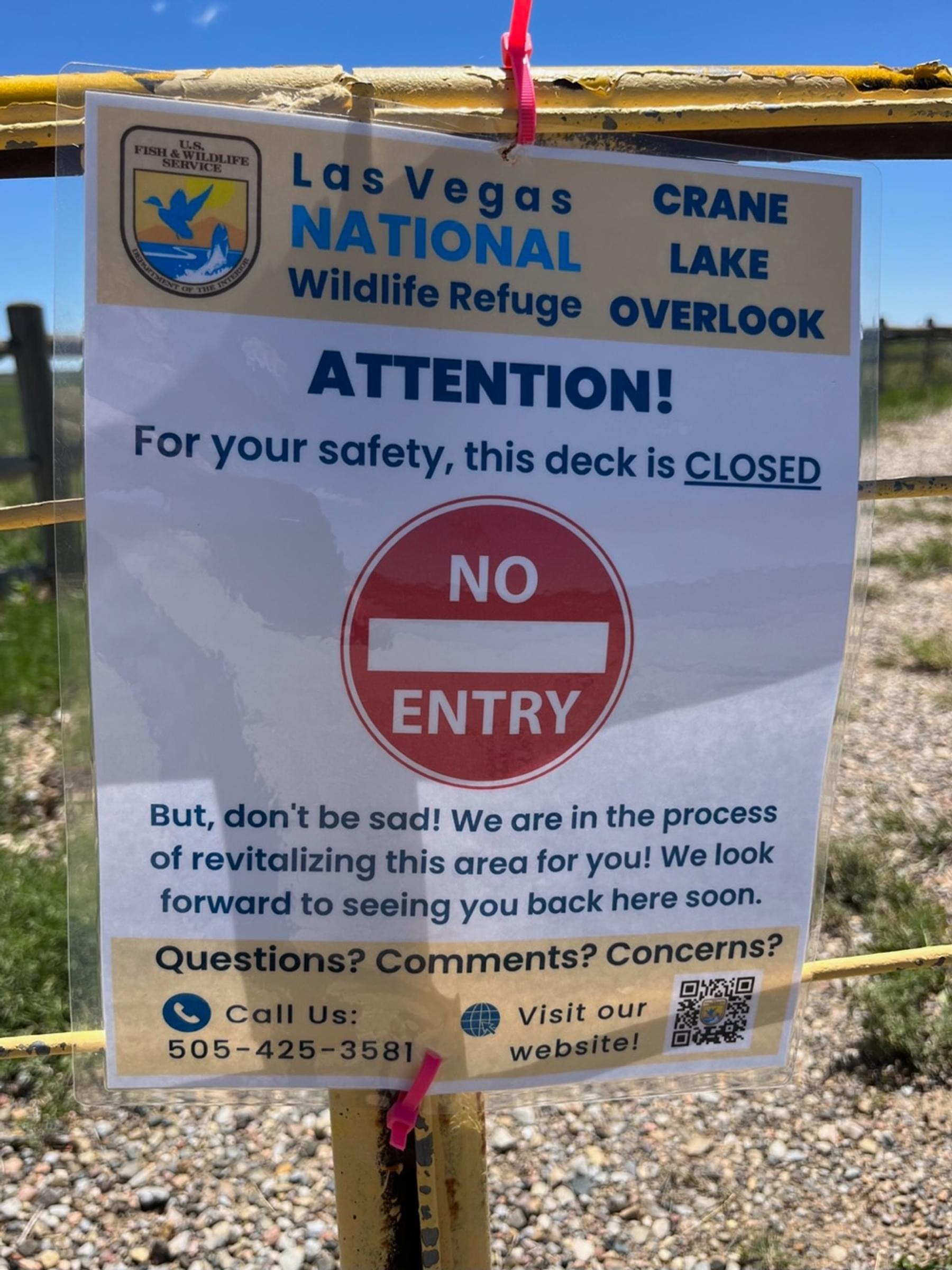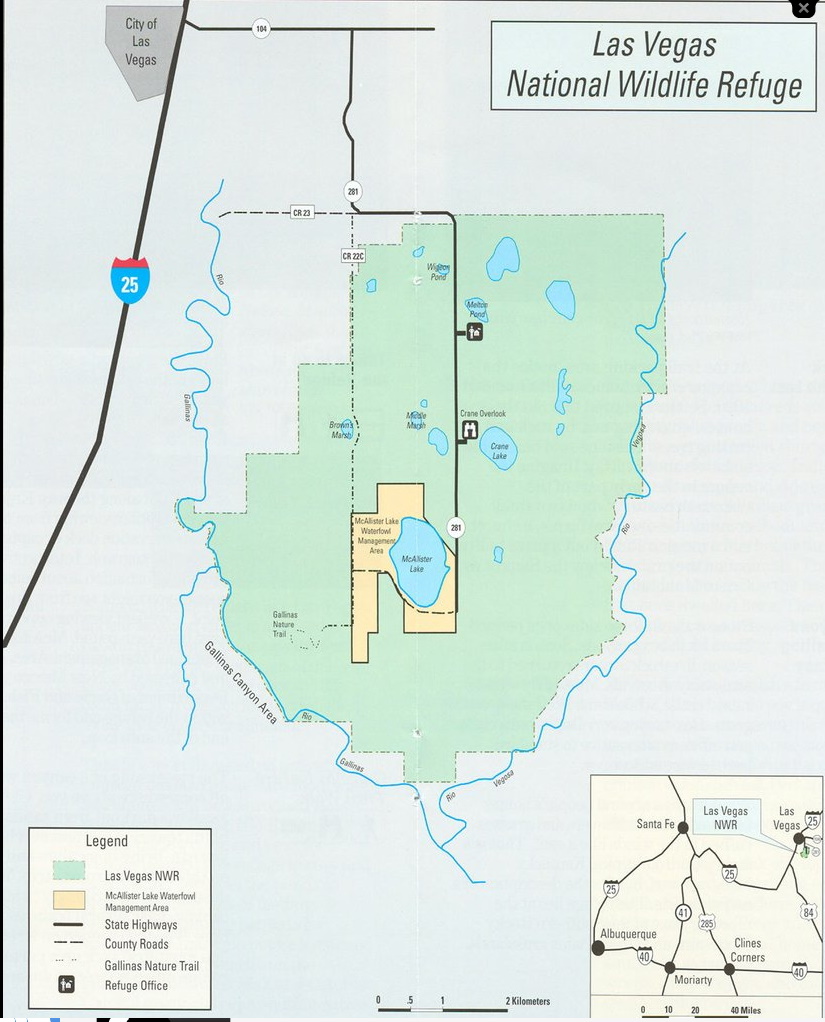Las Vegas NWR--Crane Lake (closed for renovation)

Las Vegas NWR--Crane Lake (closed for renovation)
Las Vegas, New Mexico 87701
Las Vegas National Wildlife Refuge Official WebsiteLas Vegas National Wildlife Refuge map
Tips for Birding
Bring your own spotting scope if you notice water in the lakebed.
About this Location
The area at this hotspot has been closed for renovation.
Despite being one of the top ten hotspots in the county, ranked by species, even if the hotspot were open you would be unlikely to see anywhere near the historical diversity or abundance of birds here that there once was. The reason is that the lake is dry and has been for many years, which appears unlikely to change soon.
The Fred Quintana Overlook, a wooden observation deck with two spotting scopes, from which the observations comprising most of the hotspot’s lists were made, had not been maintained since 2019 or early 2020; a gate closing off vehicular access to the deck from the gravel pull-out on the east side of NM-281 was installed at that time and has been locked since then. For a while, visitors could pass through a stile on the south side of the gate and walk 150 yards to the deck. However, public access to the area has now been prohibited, and demolition of the deck is planned. The USFWS aspires to replace the deck with a covered if not totally enclosed observation and interpretation facility.
The old deck, and presumably new facility, location lies a quarter to a third of a mile from the center of the lakebed, that is, from the hotspot map pin. The near shore would be about half that distance. The lake was historically filled with irrigation water diverted from the Gallinas River into Storrie Lake, water which then made its way through farmlands into Bentley Lake at the north end of the Refuge, from where it was distributed to other areas of the Refuge and eventually into McAllister Lake Wildlife Management Area via a set of ditches and pipes. As a result, there was adequate water to attract large numbers of winter waterfowl migrants. However, the combination of long-term drought – reducing water released from Storrie Lake – and infrastructure deterioration between Bentley Lake and Crane Lake means the latter has been dry for many years. The USFWS does intend to repair the broken infrastructure, which may allow not only the filling of Crane Lake but also the resumption of farming on the Refuge, an added attraction for winter migrants. At this time, any water in Crane Lake would typically be ephemeral, coming from the summer monsoon or heavy spring rains.
About Las Vegas National Wildlife Refuge
See all hotspots at Las Vegas National Wildlife Refuge
Spanish for "the meadows," Las Vegas National Wildlife Refuge’s history dates as far back as 8,000 BC when old-world Indians inhabited the high plains area.
Pueblo Indians also spent time living in this region, until the 1100s when drought and Apaches forced them out. In the mid-1500s, Spanish conquistadors and missionaries explored and settled the region, and the influence of Spanish culture is still felt today. Westward expansion continued in the late 1800s, and by the turn of the century, the Santa Fe Trail and the railroad made Las Vegas, New Mexico, the place to be.
In 1965, the Las Vegas National Wildlife Refuge was established by the authority of the Migratory Bird Conservation Action for the benefit of migratory birds. The 8,672-acre refuge represents one of the few sizeable wetland areas remaining in New Mexico. It is open to the public for wildlife-dependent recreation, including wildlife watching, hiking, hunting, educational and interpretive programs, and special events.
Here, the gently rolling prairies of the east abruptly meet the rugged terrain of the mountains, gravel-capped mesas and buttes, and deep, narrow river canyons. The high plains refuge is surrounded on three sides by steep, timbered canyons but within the habitat, there is short and tall-grass prairie, timbered sandstone canyons, piñon-juniper woodlands, wetlands, ponds, lakes, and riparian areas.
Above the timbered canyons, the refuge encircles more than 40 small ponds that provide tubers, seeds, and browse for waterfowl. In addition to the ponds, a number of springs discharge to the surface and support a variety of species, including several native fish like the Rio Grande chub, longnose dace, white sucker, and fathead minnow. These ponds are critical to birds migrating along the Central Flyway as they depend on the refuge as a place to rest and refuel during their long journey.
Nesting on the refuge are nearly one-third of the documented bird species found on the refuge, including long-billed curlews, avocet, Canada geese, mallards, northern pintails, blue-winged and cinnamon teal, gadwall, and ruddy ducks.
The sandhill cranes arrive in the fall as they migrate to their winter home. Bald eagles, northern harriers, and American kestrels are frequently sighted soaring above the refuge scanning the grasslands for prey or attracted to the hundreds of ducks and geese on the refuge’s open waters. Migrating shorebirds like long-billed dowitchers and sandpipers, probe the mudflats in early fall and spring. In the woodlands, wild turkeys wander in search of a meal, and on the prairies. Rocky Mountain elk blend into the grasses, home to badgers and ground squirrels.
Features
Restrooms on site
Wheelchair accessible trail
Entrance fee
Roadside viewing
Content from Las Vegas National Wildlife Refuge Official Website and John Montgomery
Last updated June 18, 2023
